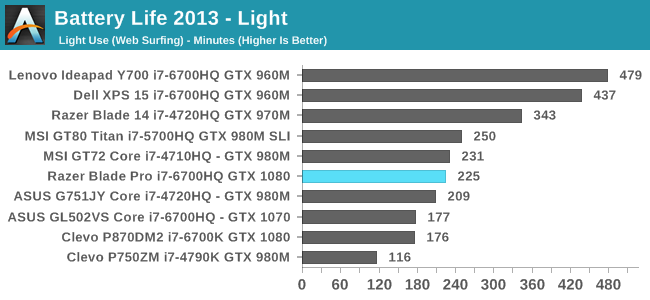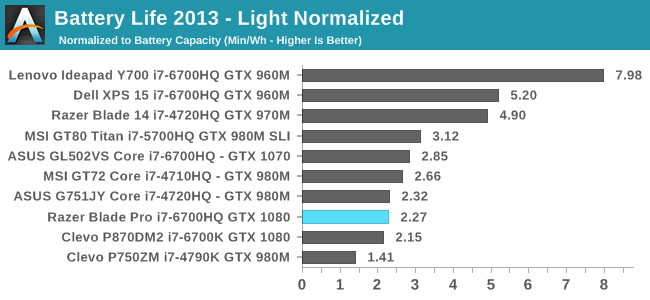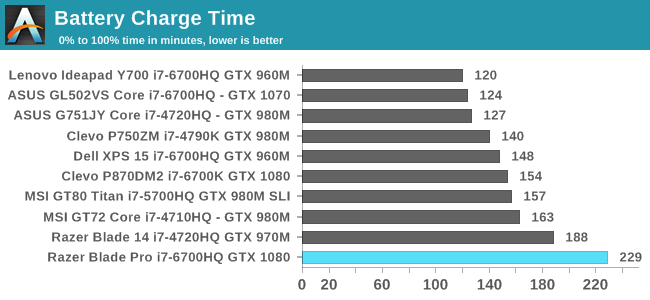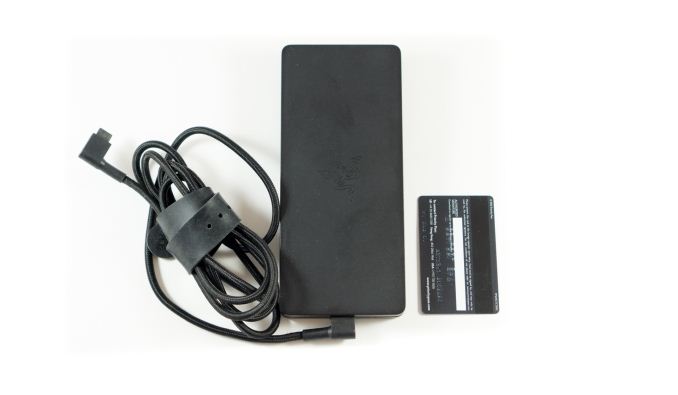The 2016 Razer Blade Pro Review
by Brandon Chester on March 6, 2017 8:00 AM EST- Posted in
- Laptops
- Razer
- Razer Blade Pro
Battery Life
It's fairly well established at this point that gaming laptops and other desktop replacement machines act more like highly portable all-in-one computers than laptops. That is to say, the battery life that you can expect when really making use of the laptop's hardware is incredibly short. With that being said, there's no reason why a gaming laptop shouldn't be able to offer decent battery life for lighter tasks like surfing the web and watching videos. Due to the static power consumption of the system it's unlikely to achieve the same sort of battery life that an ultrabook would, but users should at least be able to do web surfing or get through a movie before having to recharge.
To characterize the Blade Pro's battery life in these types of situations I've run it through our two web battery tests and our video playback test. As always, the display was set to 200 nits in order to keep results comparable between devices. To ensure consistency with the experience that other Blade Pro users will have, the testing was done using Razer's included color profile rather than the more accurately calibrated profile that I generated for the review, as the different appearance for each profile can have an impact on the power consumption if power-saving measures like content-adaptive backlight controls are utilized.
2013 Light Battery

In the old 2013 battery test the Blade Pro comes in at 225 minutes, which is 3.75 hours, or 3 hours and 45 minutes if you prefer that form. This is right in the middle of the chart, but if you compare it to other laptops that use GTX 1070 and GTX 1080 you'll find that it actually leads by a significant margin. A slightly unfair but relevant comparison is to the Clevo P870DM2, which is a desktop replacement machine that is considerably larger and heavier, but also has a desktop i7 CPU and a smaller battery. The Clevo lasts just under three hours, so the Blade Pro has an advantage if you're looking for an incredibly powerful laptop that can be used for some time off of a charger.
2016 Web Battery

In the newer 2016 web browsing test the Razer Blade Pro lasts almost exactly as long as in the older 2013 test. This would suggest that the additional workload of the newer web test is not really relevant next to the static power consumption of the laptop, and if that is the case, users should be able to expect similar battery life for all lightweight tasks.
Normalized Battery Life


While not directly relevant to consumers, it's interesting to look at a device's battery life as a function of its battery capacity in order to get an idea of how efficient it is. As you can see, while the Blade Pro does last longer than the Clevo P870DM2 in our web browsing tests, it did so with the help of a larger battery, and the normalized battery life relative to the capacity of the battery is very similar. It's worth noting that the Blade Pro achieves this with a UHD display, while the Clevo was tested with a 1080p panel, and so I would argue that Razer's result is the more impressive of the two. Of course, the Clevo is disadvantaged by using a desktop CPU, but being able to scale down power for light workloads is necessary for a laptop.
Tesseract Score


In our video playback battery test the Blade Pro comes in at 3.88 hours, which is ever so slightly longer than the web tests which clocked in around 3.75 hours. This is a pretty solid confirmation that the Blade Pro's battery life will be consistent for all these light workloads, as the additional power consumption of a lightweight task is small relative to the fixed platform power of the laptop. As for the Tesseract score, the Blade Pro can't last long enough to get through two cycles of a 143 minute movie, which is a fairly standard length for a movie nowadays, so I'd recommend keeping the power supply handy.
Based on these tests, one can conclude that the Razer Blade Pro provides between three and four hours of battery life for general lightweight tasks like web browsing and watching videos. Razer isn't able to take advantage of Optimus because of the inclusion of G-SYNC, so you're always running off the GTX 1080. With heavier workloads that make greater use of the GPU I've found that the battery depletes rapidly, so I don't recommend trying to play a game without the laptop being plugged in. However, having four hours of battery life is honestly not that bad for such a high performance machine, and it compares favorably to desktop replacement machines from other vendors because, in addition to lasting longer, the total mass of the Blade Pro and its power supply is still much less than a DTR from Clevo or MSI on its own.
Charge Time
The 2016 Razer Blade Pro comes with a 250W power supply, and given that you can only expect a few hours of usage at best, it's one that you'll want to keep with you. Thankfully, it's not incredibly thick like the power supply for Clevo laptops, so it can fit into the inner pockets of many bags without much difficulty. It is still relatively heavy compared to something like Apple's 85W MacBook charger though, so it's a good idea to take it into consideration when deciding whether you want to carry the Blade Pro somewhere.

The Blade Pro has a 99Wh battery which is the biggest battery Razer could ship while complying with airline regulations. With such a large battery and a 250W PSU, the charge time is naturally going to be longer than something like the Clevo P870DM2 which only has an 82Wh battery and a 330W PSU. Having actually used Clevo's power supply, I will say that Razer's solution is basically half the size and mass, and I think that having a slightly longer charge time is worth it to avoid further increases to the mass of the laptop + PSU combo. You can see the size of the Blade Pro charger in the image above, with a credit-card sized card for reference. Additionally, you'll almost always have the Blade Pro plugged in anyway, so a slightly longer-than-average charge time really doesn't present a real-world problem.











57 Comments
View All Comments
sorten - Monday, March 6, 2017 - link
I prefer plastic laptops to aluminum because I don't want to rest my wrists on a cold laptop in the morning. To each their own.akdj - Tuesday, March 14, 2017 - link
I could be completely wrong but I think I remember seeing a documentary on the building of the triple 7 and 787 (Boeing) and their carbon fiber testing, the results and a line I thought was interesting from one of the folks speaking was his comparison with the aluminum and titanium alloys we'd been using and perfecting... was something to the effect of 'carbon fiber while 'stronger' in some situations and better dealing with fatigue over time... it's not as 'tough' as the metals - in that tests of the fuselage and, I believe, a 'drop test' actually 'broke' the CF fuselage while denting the aluminum fuselage...a test simulated as a hard landingThe findings were escaping from an aluminum fuselage was more survivable than the CF/composite airframe in the case of a post breakup fire (aluminum dented will keep the fire out while the carbon fiber breaking was an immediate entry for fire to the cabin and more fuel)
Not that this has any relevance lol...but the cases you mentioned were also low weight situations (race and space) where 'break ups' are built to absorb energy or for atmospheres with no... atmosphere. Or 'pressures', winds, etc.
Good stuff but metal laptops are just great!
DanNeely - Monday, March 6, 2017 - link
With NVidia calling the current gen of laptop GPUs as being equal to the Desktop versions, I think you should include the desktop cards in the GPU result tables.SkipPerk - Wednesday, April 19, 2017 - link
You still have clock speed differenceszeeBomb - Monday, March 6, 2017 - link
A laptop that I'll (probably) never getzeeBomb - Monday, March 6, 2017 - link
“Using two SSDs in RAID0 is not beneficial, but it does have many drawbacks.” ???Faulty paralleslm here?
Brandon Chester - Monday, March 6, 2017 - link
Good catch. That sentence is a bit awkward. "Not beneficial" was meant to mean, not advantageous. I've reworded it.zeeBomb - Monday, March 6, 2017 - link
OK great. I guess my quick proof reading helped in class hahaZan Lynx - Monday, March 6, 2017 - link
The reviewer keeps harping on the CPU performance, but never acknowledges that a faster CPU would change the power and heat envelope, requiring a bigger power supply, more cooling and a bigger case.Brandon Chester - Monday, March 6, 2017 - link
The TDP of i7-6700HQ and i7-6920HQ are equivalent. I have it on good authority that 6920HQ would have worked perfectly well with no changes to the design of the laptop.